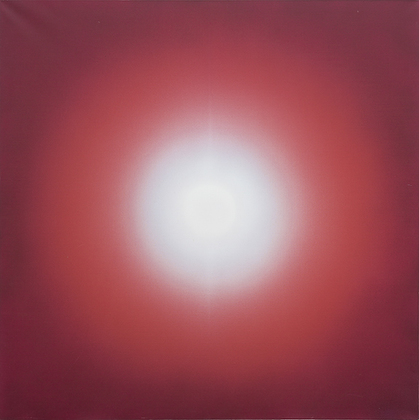-
From Current Issue
-
- Editor’s Letter Fire in the Heart
- Reviews I Gusti Ayu Kadek Murniasih
- Reviews 11th Seoul Mediacity Biennale: “One Escape at a Time”
- Dispatch Networked China
- One on One Monira Al Qadiri on Yukio Mishima
- Essays The rise of independent art spaces in pandemic-era Shanghai
- Features Tuan Andrew Nguyen
- Table of Contents
- Web Exclusives
- Archive
- Subscribe

R
E
V N
E
X
T
Installation view of HON CHI FUN’s “A Story of Light” at Asia Society Hong Kong Centre, 2019. Courtesy the artist and Asia Society Hong Kong Center.
“Daring” and “experimental” are two of the words that describe Hon Chi Fun. His solo exhibition, “A Story of Light,” at the Asia Society Hong Kong Center, evidenced his innovative approaches. With 26 works borrowed from public institutions and private collections, the show was divided into three sections, spanning four decades of his practice, and his affinities for abstract expressionism, pop art and contemporary ink.
In the first section, “Local Avant-Garde”—focused on the major breakthroughs in Hon’s career—Bath of Fire (1968) announced the artist’s reemergence from the ashes of his past. The triptych is a significant piece that marks the beginnings of the artist’s experimentation with the mixture of silkscreen prints with oil and acrylic paints, as well as loud, pop-art-inspired colors. As if scorched into the surface of the canvas, fragments of images, letters, and poetry evincing Hon’s personal life, together with lines from the Surangama Sutra—which touches on life’s transitory experiences—are imprinted in sharply contrastive reds, greens and blues. Splashes of oil paint appear to leak from the edges of the rectangles and circles that divide the composition. The more eagerly one tries to discern Hon’s past from the scraps of information, the more dizzying the viewing experience becomes. While Bath of Fire was visually jolting, on the opposite wall were a series of contemplative Polaroids, pushing materials boundaries in an equally creative manner. Made in the 1980s, the images, showing colorful halos hovering over chairs or doors, result from Hon’s manipulations of the Polaroids’ photochemicals, as well as light-refracting orbs. The Untitled works thus toy with the confines of the photographic medium.
In the bilingual setting of Hong Kong, local visitors likely realized that most of the English titles of Hon’s works are not direct translations of their Chinese counterparts. As a result, viewers were provided with at least two possible interpretations to his works. This was apparent in the second chamber, “Distilled Desires,” where three airbrush-painted pieces, connected by the topic of romance, were on view. A white light radiates from the center of Ours Ever (1974) and seeps into the composition’s deep red outer edges, evoking the illuminance of one’s “pure heart”—as suggested by the Chinese title—that is experienced as primitive passion. Secret Codes (1974) is a canvas dedicated to Hon’s wife, the local contemporary artist Choi Yan Chi. Here, amid gradient grays, a concentrated bright spot resembles the light at the end of a narrow tunnel. With a Chinese title (卿卿; an archaic term of endearment) referring to the intimate relationship between husband and wife, perhaps the image can only be decoded by the couple themselves. In the tone of blue, Up and Away (1974) shows a floating sphere in the sky. It’s difficult to tell whether the orb is approaching the viewer or flying away, bringing to mind an “endless pursuit.”
Opening the third section, “Here, There and Everywhere,” was Nil and Void (1996), a composition with a lightly spray-painted layer of white revealing a circle, made up of dynamic black, white, red and gold marks. Next to the circle is a calligraphic line from the Heart Sutra: “All Dharmas are empty of characteristics. They are not produced nor destroyed.” Aside from works that articulate Hon’s religious beliefs and obsession with circles, the section also included abstracted landscapes based on his travels around the world. His adventurous spirit is captured in Plunge and Live (1999), displayed at the very back of the exhibition. The collage of painted, rectangular fragments depicting the rapid waters of Iguazu Falls was created when the couple revisited the site 20 years after the artist fell into the stream during a solo trip. The breathtaking strokes effectively recall the force of nature, celebrating Hon’s miraculous escape and life itself.
Hon’s impulse to express himself is palpable throughout his oeuvre, yet he always resisted revealing the complete picture. For Hon, art is an ongoing story. “Painting demands being innovative, being in sync with the times and being of one’s own,” he said. By tracing the changes in his art, “A Story of Light” provided visitors with the chance to understand not just Hon’s artistic innovations, but his evolving views of life.
Pamela Wong is ArtAsiaPacific’s assistant editor.
Hon Chi Fun’s “A Story of Light” is on view at the Asia Society Hong Kong Center until June 9, 2019.
To read more of ArtAsiaPacific’s articles, visit our Digital Library.



















